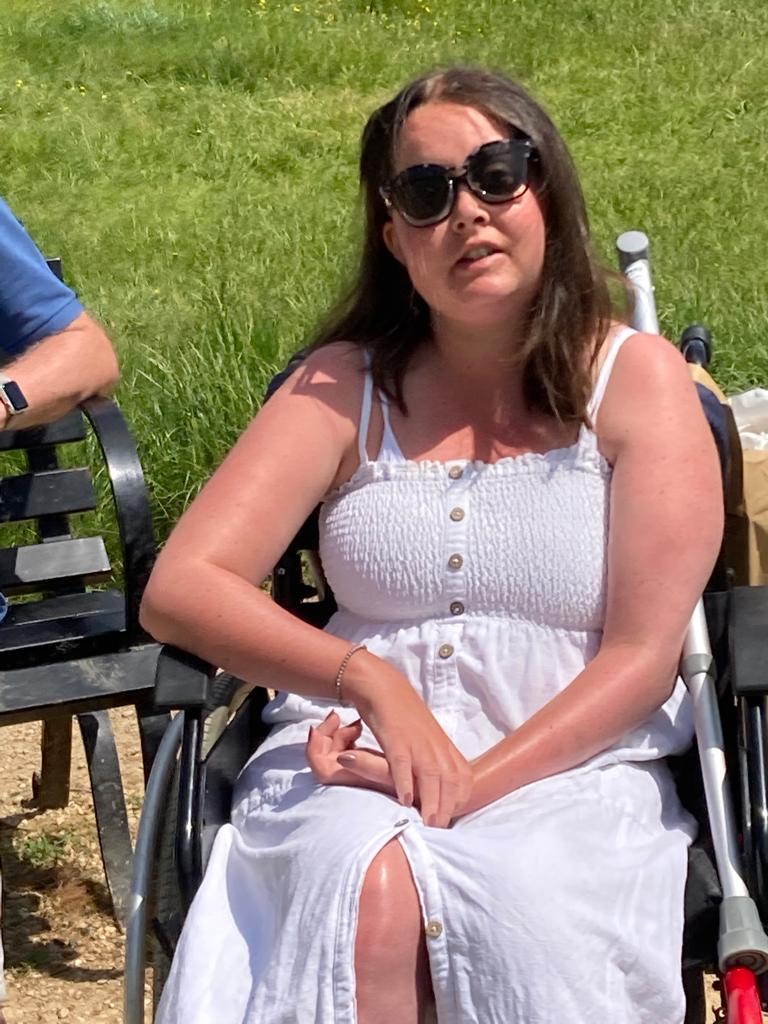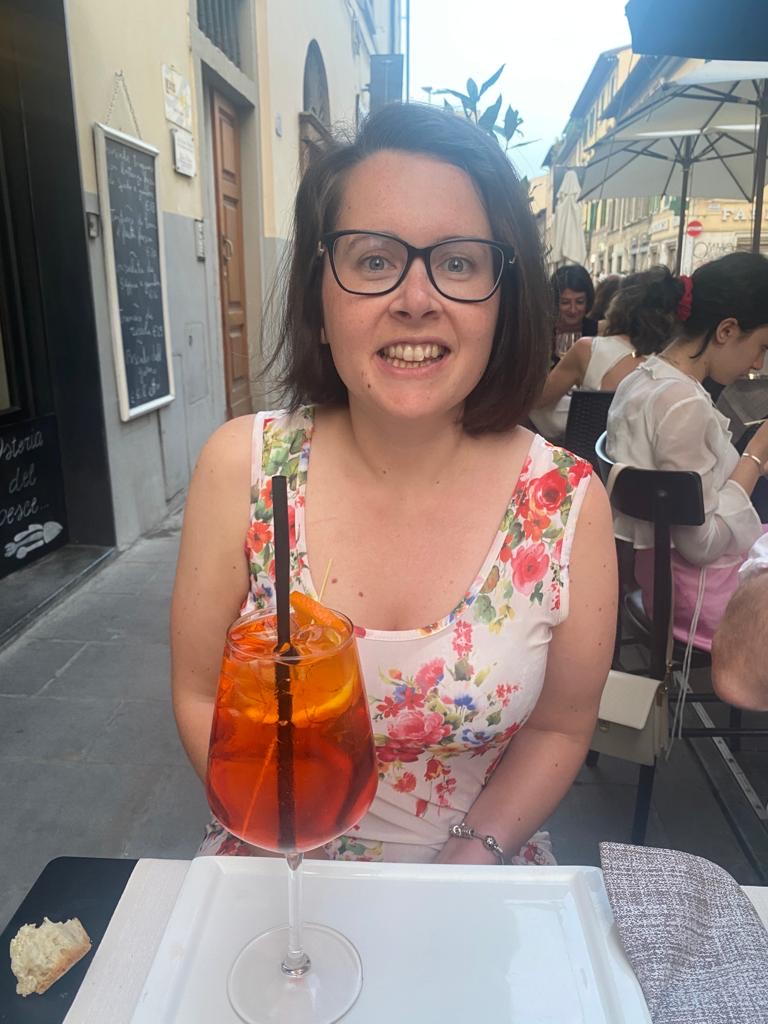Chloe, a 28-year-old from London, had a zest for life, and a busy lifestyle as an International Events Organiser. Until the COVID-19 lockdowns she was travelling regularly around the world and was loving her hectic social life. Then, after moving back in with her parents for the COVID-19 lockdown, she found she was experiencing constant fatigue, eyestrain, and headaches (common brain tumour symptoms). She tried to ignore these symptoms for a couple of months as her family focused on her sister’s wedding, but when she started getting episodes of double vision she went to her GP. She said, “My GP thought it might be migraine headaches, but she referred me to see a specialist at Kings Hospital in London. The consultant sent me for a scan.”
Chloe said, “Unfortunately it seemed to take a long time to get the scan appointment. I knew something was wrong and three days after I went back to my flat after lockdown, I had a weird episode with my eyes. I kept seeing black and white flashing lights and that was really scary. I called my mum, and she took me to Kings A&E Hospital to get a scan done quickly.” That was in September 2020.
After a day of tests, Chloe was admitted to the neurological ward, because the doctors had found ‘abnormalities’ on her scan. At 2.00am, Chloe was awoken to the news that she had a build-up of cerebrospinal fluid in the brain, also known as hydrocephalus, being caused by a brain tumour. She needed an emergency operation to have an Ommaya reservoir inserted – to clear the fluids’ pathway – and a biopsy to learn more about the type of tumour that had been seen.
The initial biopsy showed Chloe had a low-grade pilocytic astrocytoma brain tumour that, unfortunately, the doctors were not able to remove due to the sensitivity of its midbrain location. “After further DNA testing of my tumour – or Trev, as I like to call him – some markers suggested it could become aggressive in the future, and the recommended treatment was 33 rounds of radiotherapy followed by 12 rounds of temozolomide chemotherapy – tablets taken monthly.”
Chloe said, “My colleagues, friends, and family have all been so amazing. I have such a strong support system, I call them ‘Team Chloe’, and I cannot overstate how important this is. Team Chloe sent me cards, flowers, messages and presents throughout my treatment and made me feel very supported and loved even when we couldn’t meet because of the pandemic. They all say how proud they are of me and how strong I am enduring all the treatment and the side effects – that’s nice to hear because sometimes I don’t feel as brave as they say I am!”
“As lockdown restrictions began to ease, having visitors over and going on family outings was very important – even just short walks to the pub, the park or simply in my parents’ garden were special and helped keep me in touch with my old life. There were certainly days when I didn’t really feel like going out, and some when I could barely walk to the end of my parent’s garden, but we just tried to keep life as simple and normal as possible – and this was important to me. They helped me attend hen parties and weddings and special events in my friends’ lives too. I really didn’t want to miss out and although I don’t look myself in the photos of these events, at least I was there and share the memories with my friends. They were all lovely to me. Our family dogs were also great for my mental health and spent hours on the sofa with me!”
Initially Chloe had only mild side effects from the treatment – some hair loss and fatigue, but late swelling around her tumour (as it reacted to the treatment) caused bigger reaction. Chloe said, “My double vision seemed to be worse than ever, and I had to wear an eye patch. I also lost my balance and started falling a lot and I developed weakness down my entire left side.”
Moreover, Chloe said when she was at her worst, she had to use a wheelchair and a walking stick, and needed help eating, getting dressed, taking showers, and essentially just moving around. “I was on a lot of steroids to treat the swelling, and I ended up gaining two stone in weight and did not look like myself at all. Luckily, I didn’t realise how much I had changed physically, but I think it was hard for my family and friends to see me like that. Thankfully it didn’t last, although it took some hard work to get fit again.”
Because of the side-effects, Chloe took a break from chemotherapy part way through and focused on physical therapy and swimming. “At first it was a huge effort to even get in the pool and I could only walk up and down two lengths with my mum supporting me. Mum consistently encouraged me and tried to make it fun, and it slowly got easier.”


Chloe’s mum also heard about a drug called Avastin (bevacizumab), which her medical team confirmed can sometimes help reduce swelling around a tumour. It is not available through the NHS for brain tumours, but Chloe’s parents decided to pay for the medication and within a week of the first Avastin infusion her mobility started to improve. So much so she was able to dance at her friend’s party and began walking better. Chloe continued to have the Avastin alongside the further rounds of chemotherapy to keep the swelling under control, which it did.
By February 2021, Chloe felt ready to think about living independently again. She bought her own flat in Horsham, near her parents’ home and got all the family involved in decorating and furniture removals Chloe said, “This was such an incredible step and made me feel my life was restarting again!”
Chloe continues to have weakness in her left hand and has had to learn to write with her right hand (she was previously left-handed) and her eyesight remains impaired, but she said, “I have had to adapt and learn to cope with my body how it is now, and when I look back, I can see I have had to relearn so much.”
Chloe also uses Sativex, an oromucosal spray containing cannabinoids THC and CBD, after hearing from other patients who had used it – which she accesses privately.
Thanks to the generosity of The Brain Tumour Charity’s supporters, a phase II trial of Sativex at 15 NHS hospitals is also set to begin to assess whether the drug may be effective in treating recurrent glioblastomas, funded by The Charity.
Chloe said, “My family and I have spoken to others who found it very successful, so I have been using it since my treatment began. I am hopeful to see what the trial results in glioblastomas will be.”
“The Brain Tumour Charity has been especially helpful as they have provided my family and I a great resource for information to the questions my family and I had following my diagnosis. Also, I really like that The Brain Tumour Charity stays up to date on the latest trials, treatments, and research.”
Chloe has now resumed her travels by going to Portugal and Italy and is currently planning to do another to Barcelona. She has also begun a phased return to work. She has MRI scans every three months to monitor her tumour and continues with sessions in the gym and pool to rebuild her strength and fitness. She has regular checks on her eyes too but feels better every day.
Chloe continues to have access to a clinical nurse specialist and said, “It has been great to have someone to speak to if I have concerns. She is incredibly supportive, and it is so good to have someone who really understands what I am going through, because she has seen patients deal with similar situations. She truly helped my mum to keep calm and stay positive when things started to not look so good. She also found me a ‘buddy’ who had many similar side effects to those I was experiencing, and we keep in touch by email. She has given me some good tips and helped me to understand the treatment and recovery process can take a long time and needs hard work and positive thinking on my part!”
Chloe added, “There is a vast amount of information available, but it is not all relevant to your own circumstances. I read some terrible stories online and I was drawn into other people’s traumas which didn’t really help me at all. My dad had a rule, ‘No speculation; it’s just going to take Tea, Toast & Time.’ So, we tried to just take it one day at a time and not to worry about what could happen.”


“I came to realise a few things – every tumour is different, every patient reacts differently to treatment, and every tumour behaves differently. Nothing is certain and you have to learn to live with that uncertainty but also you have to focus on your own situation not everyone else’s. As my family and I like to say, ‘It is what it is’. You just have to get on with it and make the best of every day – even the bad days, they do pass. You can still have fun, laugh, and hang out with lovely friends. For me, it was being with my friends and family that really helped me to feel normal again, and to believe that I can have a great life after treatment. I am really excited to be going back to my job (part time for now), planning holidays, and having fun. Learning to live with a brain tumour is challenging but you just have to stay positive and try to – make the most of every day – even if it is a day when you need to just laze around on the sofa, eating tea and toast.”
